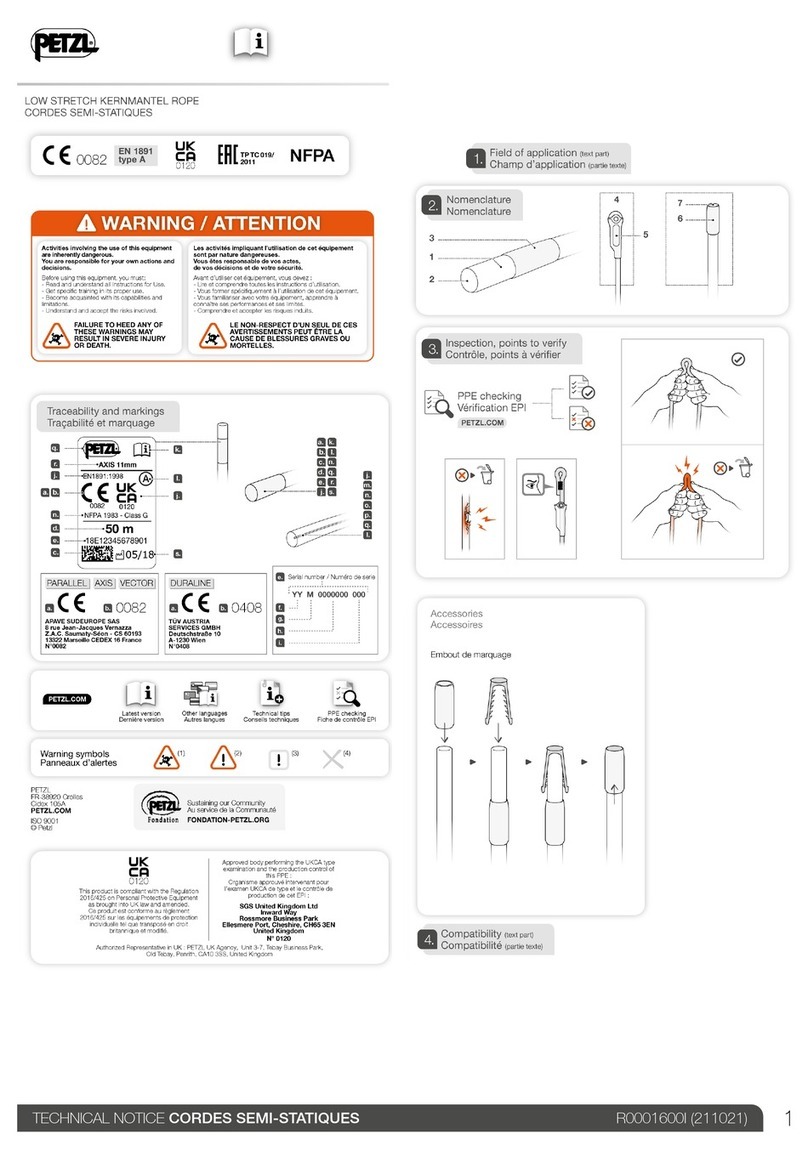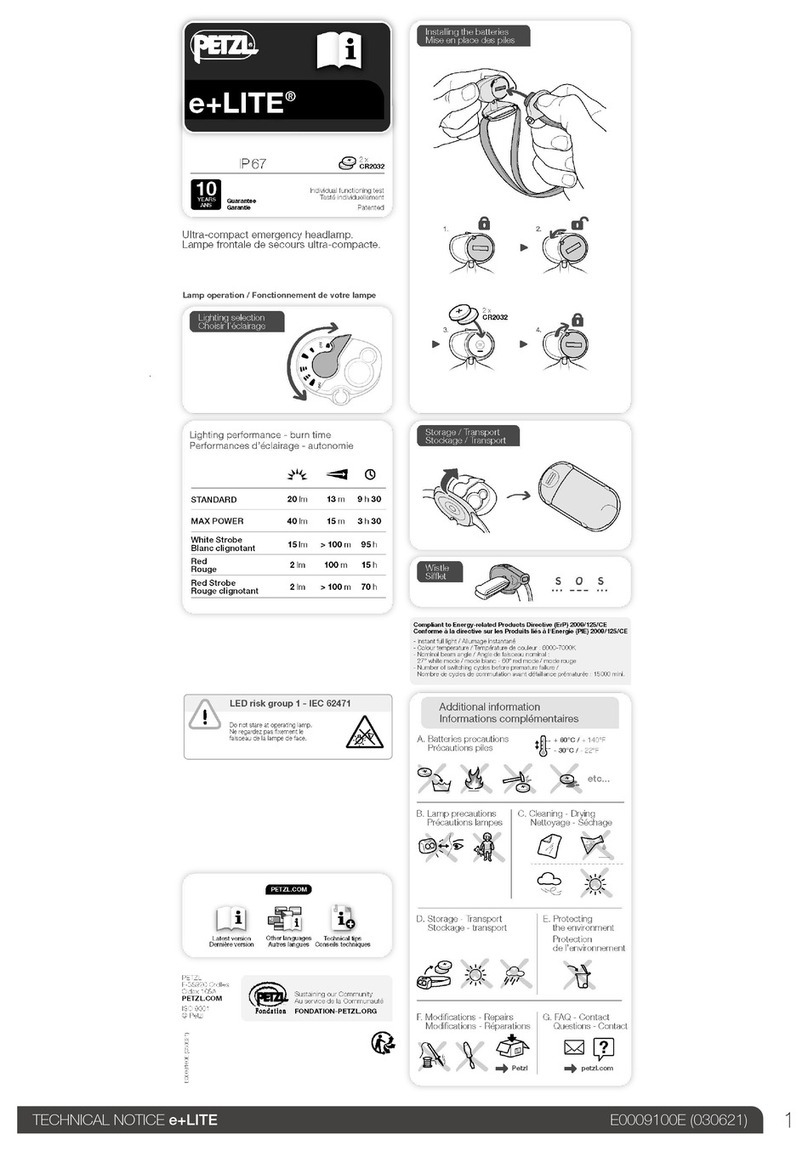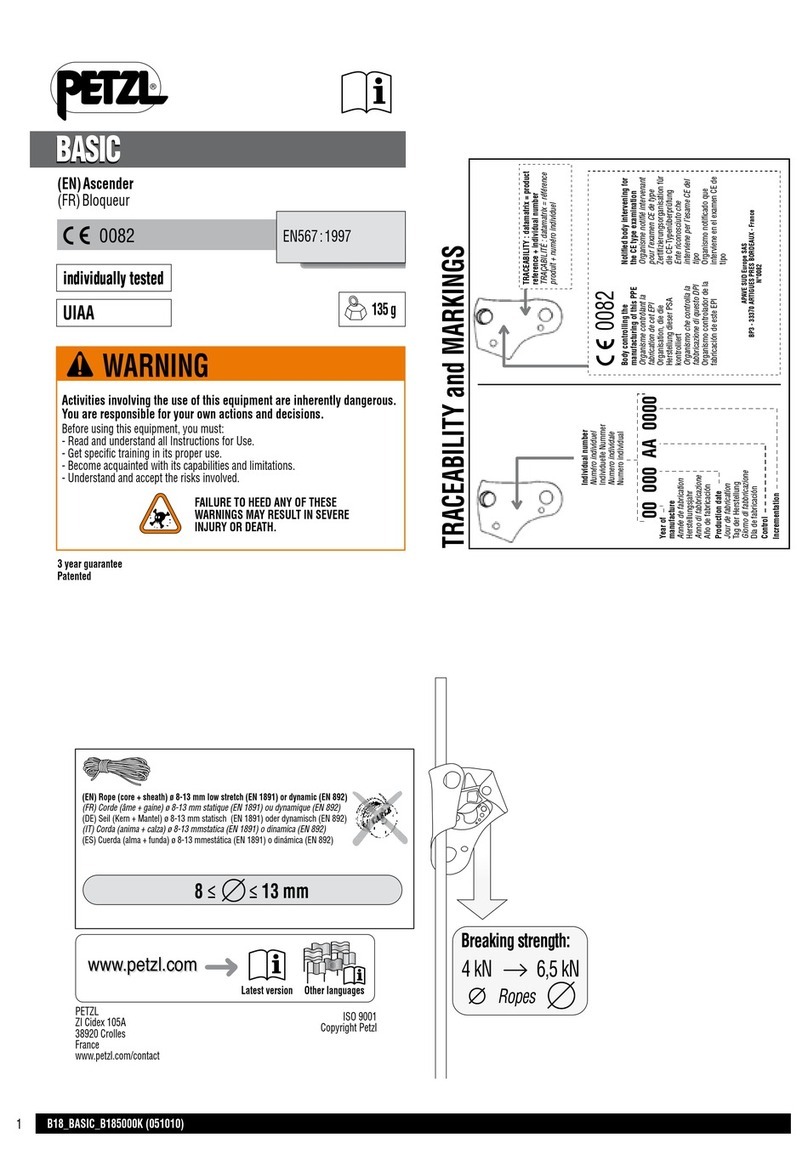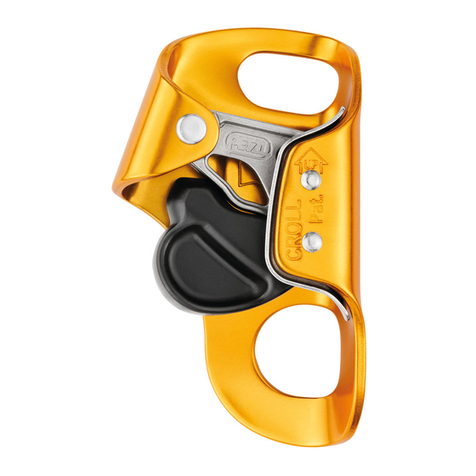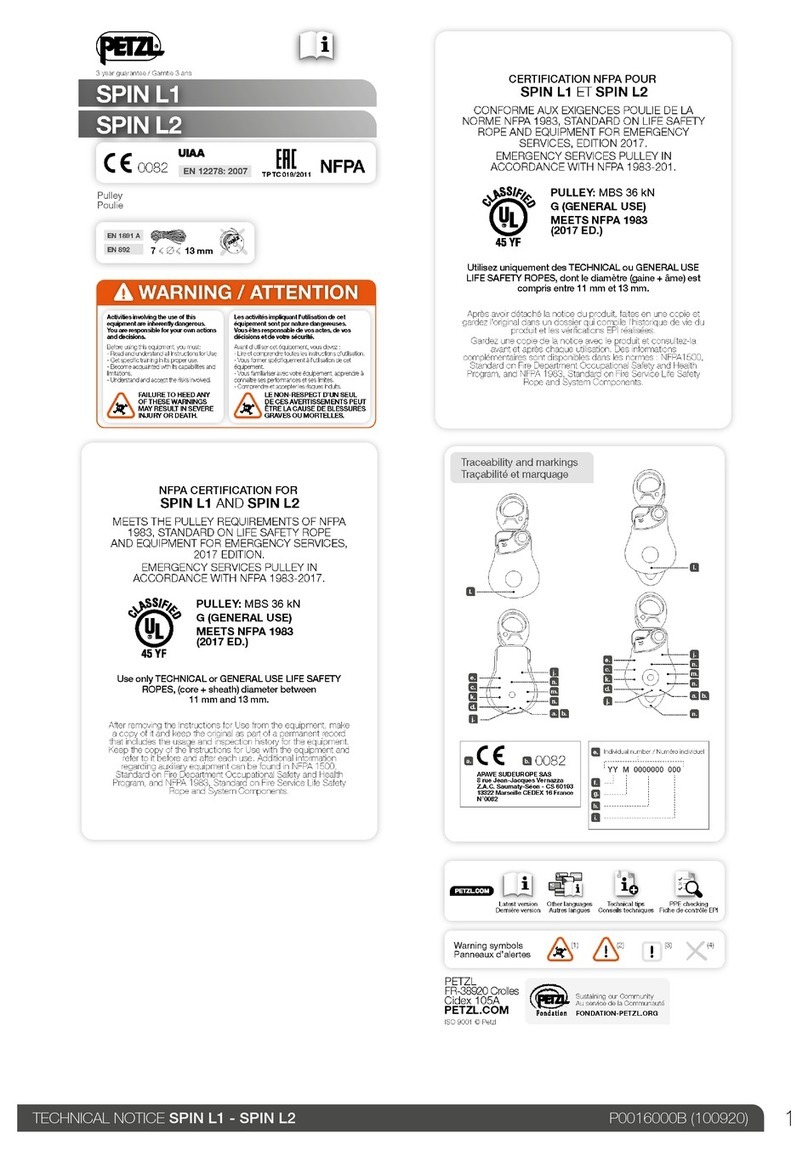
TECHNICAL NOTICE OK TRIACT-LOCK M0025500A (280219)
4
DE
In dieser Gebrauchsanweisung wird erklärt, wie Sie Ihr Produkt richtig verwenden.
Es werden nur einige der Verwendungen und Techniken dargestellt.
Die Warnhinweise informieren Sie über mögliche Gefahren bezüglich der
Verwendung Ihres Produkts. Es ist jedoch nicht möglich, alle erwägbaren Fälle zu
beschreiben. Bitte nehmen Sie Kenntnis von den Aktualisierungen und zusätzlichen
Informationen auf Petzl.com.
Sie sind für die Beachtung der Warnhinweise und für die sachgemäße Verwendung
Ihres Produkts verantwortlich. Jede fehlerhafte Verwendung des Produkts bedeutet
eine zusätzliche Gefahrenquelle. Wenn Sie Zweifel haben oder etwas nicht richtig
verstehen, wenden Sie sich bitte an Petzl.
1. Anwendungsbereich
Persönliche Schutzausrüstung (PSA) zum Schutz gegen Absturz.
EN 362: 2004 Klasse B (Basismodell), EN 12275: 2013 Klasse B (Basismodell).
Karabiner mit automatischer TRIACT-LOCK-Verriegelung für Aktivitäten, bei denen
ein Absturzrisiko besteht.
Das Produkt entspricht der PSA-Verordnung (EU) 2016/425. Die EU-
Konformitätserklärung ist auf Petzl.com verfügbar.
Dieses Produkt darf nicht über seine Grenzen hinaus belastet werden. Es darf
ausschließlich zu dem Zweck verwendet werden, für den es entwickelt wurde.
Haftung
WARNUNG
Aktivitäten, bei denen diese Ausrüstung zum Einsatz kommt, sind
naturgemäß gefährlich.
Für Ihre Handlungen, Entscheidungen und für Ihre Sicherheit sind Sie selbst
verantwortlich.
Vor dem Gebrauch dieser Ausrüstung müssen Sie:
- Die Gebrauchsanleitung vollständig lesen und verstehen.
- Fachgerecht zur richtigen Benutzung der Ausrüstung ausgebildet sein.
- Sich mit Ihrer Ausrüstung vertraut machen, die Möglichkeiten und Grenzen kennen
lernen.
- Die mit dem Einsatz verbundenen Risiken verstehen und akzeptieren.
Die Nichtberücksichtigung auch nur einer dieser Warnungen kann zu
schweren Verletzungen oder sogar Tod führen.
Dieses Produkt darf nur von kompetenten und besonnenen Personen verwendet
werden oder von Personen, die unter der direkten Aufsicht und visuellen Kontrolle
einer kompetenten und besonnenen Person stehen.
Sie sind für Ihre Handlungen, Entscheidungen und für Ihre Sicherheit verantwortlich
und tragen die Konsequenzen. Wenn Sie nicht in der Lage sind, diese
Verantwortung zu übernehmen, oder wenn Sie die Gebrauchshinweise nicht richtig
verstanden haben, benutzen Sie diese Ausrüstung nicht.
2. Benennung der Teile
(1) Körper, (2) Schnapper, (3) Niete, (4) Verriegelungshülse, (5) Keylock.
Hauptmaterialen: Aluminium.
3. Überprüfung, zu kontrollierende Punkte
Ihre Sicherheit hängt vom Zustand Ihrer Ausrüstung ab.
Petzl empfiehlt, mindestens alle 12 Monate (entsprechend den in Ihrem Land
geltenden Vorschriften und den Nutzungsbedingungen) eine eingehende
Überprüfung durch eine kompetente Person durchführen zu lassen. Bitte beachten
Sie die auf Petzl.com beschriebenen Vorgehensweisen. Tragen Sie die Ergebnisse
in den Prüfbericht Ihrer PSA ein: Typ, Modell, Kontaktinformation des Herstellers,
Seriennummer oder individuelle Nummer, Daten: Herstellung, Kauf, erste
Anwendung, nächste regelmäßige Überprüfung, Probleme, Bemerkungen, Name
und Unterschrift des Prüfers.
Vor jedem Einsatz
Vergewissern Sie sich, dass Körper, Niete, Schnapper und Verriegelungshülse keine
Risse, Deformierungen, Korrosions- oder Abnutzungserscheinungen aufweisen.
Überprüfen Sie das Öffnen und automatische Schließen des Schnappers. Der
Keylock-Schlitz darf nicht blockiert oder verstopft sein.
Überprüfen Sie die Ver- und Entriegelung der Hülse.
Während des Gebrauchs
Vergewissern Sie sich, dass der Karabiner immer in der Längsachse belastet wird.
Kontrollieren Sie die Verriegelung der Hülse in regelmäßigen Abständen. Vermeiden
Sie jeglichen Druck oder Reibung, da dies zur Entriegelung des Schnappers bzw.
zur Beschädigung der Verriegelungshülse führen könnte.
Es ist unerlässlich, den Zustand des Produkts und seiner Verbindungen mit anderen
Ausrüstungsgegenständen im System regelmäßig zu überprüfen. Stellen Sie stets
sicher, dass die einzelnen Ausrüstungsgegenstände im System richtig zueinander
positioniert sind.
4. Kompatibilität
Überprüfen Sie die Kompatibilität dieses Produkts mit den anderen Elementen Ihres
Systems (Kompatibilität = funktionelles Zusammenspiel).
Die mit Ihrem Verbindungselement verwendeten Ausrüstungselemente müssen mit
den in Ihrem Land geltenden Normen übereinstimmen (z.B. Verbindungsmittel EN
354 für den Arbeitseinsatz).
5. Positionierung des Karabiners
Ein Karabiner ist nicht unzerstörbar.
Ein Karabiner weist die maximale Bruchlast in der Längsachse und bei
geschlossenem Schnapper auf. Jede andere Belastung (z.B. Querbelastung oder
bei offenem Schnapper) reduziert die Bruchlast des Karabiners und ist daher
gefährlich.
Weitere Informationen finden Sie in den technischen Tipps zum Thema
Verbindungselemente auf Petzl.com.
6. Öffnen/Schließen
Der Karabiner muss mit geschlossenem Schnapper und verriegelter Hülse
verwendet werden.
Vergewissern Sie sich bei jedem Schließvorgang, dass die Hülse vollständig
verriegelt ist.
7. Zusätzliche Informationen
- Bei einem Auffangsystem muss die Länge des Verbindungselements
berücksichtigt werden, da diese die Sturzhöhe beeinflusst.
- Der Benutzer muss für eventuelle Schwierigkeiten, die während der Anwendung
dieses Produkts auftreten können, Rettungsmöglichkeiten planen.
- Der Fixpunkt des Systems sollte oberhalb der Position des Benutzers errichtet
werden und sollte den Anforderungen der Norm EN 795 entsprechen. Die
Mindestbruchlast des Fixpunktes muss 12 kN betragen.
- In einem Auffangsystem ist vor jeder Benutzung sicherzustellen, dass genügend
Sturzraum unter dem Anwender vorhanden ist, so dass er im Falle eines Sturzes
nicht auf den Boden oder auf ein Hindernis schlägt.
- Achten Sie darauf, dass der Fixpunkt richtig platziert ist, um das Risiko und die
Höhe eines Sturzes zu reduzieren.
- In einem Auffangsystem ist zum Halten des Körpers ausschließlich ein Auffanggurt
zulässig.
- Werden mehrere Ausrüstungsgegenstände zusammen verwendet, kann es zu
gefährlichen Situationen kommen, wenn die Sicherheitsfunktion eines Gegenstands
durch einen anderen Ausrüstungsgegenstand behindert wird.
- ACHTUNG - GEFAHR: Achten Sie darauf, dass die Produkte nicht an rauen
Materialien oder scharfkantigen Gegenständen reiben.
- Anwender müssen für Aktivitäten in der Höhe gesundheitlich in guter Verfassung
sein. WARNUNG: Das regungslose Hängen in einem Gurt kann zu schweren
Verletzungen oder sogar Tod führen (Hängetrauma!).
- Die Gebrauchsanleitungen für jeden Ausrüstungsgegenstand, der zusammen mit
diesem Produkt verwendet wird, müssen unbedingt befolgt werden.
- Die Gebrauchsanleitungen müssen allen Benutzern dieser Ausrüstung in
Landessprache zur Verfügung gestellt werden.
- Vergewissern Sie sich, dass die Markierungen auf dem Produkt lesbar sind.
Aussondern von Ausrüstung:
ACHTUNG: Außergewöhnliche Umstände können die Aussonderung eines
Produkts nach einer einmaligen Anwendung erforderlich machen (Art und Intensität
der Benutzung, Anwendungsbereich: aggressive Umgebungen, Meeresklima,
scharfe Kanten, extreme Temperaturen, Chemikalien usw.).
In folgenden Fällen muss ein Produkt ausgesondert werden:
- Es wurde einem schweren Sturz oder einer schweren Belastung ausgesetzt.
- Das Produkt fällt bei der PSA-Überprüfung durch. Sie bezweifeln seine
Zuverlässigkeit.
- Die vollständige Gebrauchsgeschichte ist nicht bekannt.
- Das Produkt ist veraltet (Änderung der gesetzlichen Bestimmungen, der
Normen oder der technischen Vorschriften, Inkompatibilität mit anderen
Ausrüstungsgegenständen usw.).
Zerstören und entsorgen Sie diese Produkte, um ihren weiteren Gebrauch zu
verhindern.
Zeichenerklärungen:
A. Unbegrenzte Lebensdauer - B. Temperaturbeständigkeit - C.
Vorsichtsmaßnahmen - D. Reinigung - E. Trocknung - F. Lagerung/Transport -
G. Pflege - H. Änderungen/Reparaturen (außerhalb der Petzl Betriebsstätten nicht
zulässig, ausgenommen Ersatzteile) - I. Fragen/Kontakt
3 Jahre Garantie
Auf Material- und Fabrikationsfehler. Von der Garantie ausgeschlossen sind: normale
Abnutzung, Oxidation, Modifikationen oder Nachbesserungen, unsachgemäße
Lagerung, unsachgemäße Wartung, Nachlässigkeiten und Anwendungen, für die
das Produkt nicht bestimmt ist.
Warnhinweise
1. Unmittelbare Verletzungs- oder Lebensgefahr. 2. Potenzielles Unfall-
oder Verletzungsrisiko. 3. Wichtige Information über die Funktionsweise
oder die Leistungsangaben Ihres Produkts. 4. Inkompatibilität zwischen
Ausrüstungsgegenständen.
Rückverfolgbarkeit und Markierung
a. Entspricht den Anforderungen der PSA-Verordnung. Benannte Stelle für die EU-
Baumusterprüfung - b. Nummer der notifizierten Stelle für die Produktionskontrolle
dieser PSA - c. Rückverfolgbarkeit: Data Matrix - d. Herstellungsjahr - e.
Herstellungstag - f. Prüfung oder Name des Prüfers - g. Fortlaufende Seriennummer
- h. Bruchlast - i. Normen - j. Lesen Sie die Gebrauchsanleitung aufmerksam durch
- k. Modell-Identifizierung - l. Klasse B (Basismodell)
IT
Questa nota informativa spiega come utilizzare correttamente il dispositivo. Solo
alcune tecniche e utilizzi sono presentati.
I segnali di attenzione vi informano di alcuni potenziali pericoli legati all’utilizzo del
dispositivo, ma è impossibile descriverli tutti. Prendete visione degli aggiornamenti e
delle informazioni supplementari sul sito Petzl.com.
Voi siete responsabili della considerazione di ogni avviso e dell’utilizzo corretto del
dispositivo. L’uso improprio di questo dispositivo causa rischi aggiuntivi. Contattare
Petzl in caso di dubbi o difficoltà di comprensione.
1. Campo di applicazione
Dispositivo di protezione individuale (DPI) contro le cadute dall’alto.
EN 362: 2004 classe B (base), EN 12275: 2013 classe B (base).
Moschettone con ghiera di bloccaggio automatico TRIACT-LOCK destinato alle
attività che presentano un rischio di caduta dall’alto.
Questo prodotto è conforme al regolamento (UE) 2016/425 relativo ai dispositivi
di protezione individuale. La dichiarazione di conformità UE è disponibile sul sito
Petzl.com.
Questo prodotto non deve essere sollecitato oltre i suoi limiti o in qualsiasi altra
situazione differente da quella per cui è destinato.
Responsabilità
ATTENZIONE
Le attività che comportano l’utilizzo di questo dispositivo sono per natura
pericolose.
Voi siete responsabili delle vostre azioni, delle vostre decisioni e della vostra
sicurezza.
Prima di utilizzare questo dispositivo, occorre:
- Leggere e comprendere tutte le istruzioni d’uso.
- Ricevere una formazione adeguata sul suo utilizzo.
- Acquisire familiarità con il dispositivo, imparare a conoscerne le prestazioni e i
limiti.
- Comprendere e accettare i rischi indotti.
Il mancato rispetto di una sola di queste avvertenze può essere la causa di
ferite gravi o mortali.
Questo prodotto deve essere utilizzato esclusivamente da persone competenti e
addestrate o sottoposte al controllo visivo diretto di una persona competente e
addestrata.
Voi siete responsabili delle vostre azioni, delle vostre decisioni e della vostra
sicurezza e ve ne assumete le conseguenze. Se non siete in grado di assumervi
questa responsabilità, o se non avete compreso le istruzioni d’uso, non utilizzare
questo dispositivo.
2. Nomenclatura
(1) Corpo, (2) Leva, (3) Rivetto, (4) Ghiera di bloccaggio, (5) Keylock.
Materiali principali: alluminio.
3. Controllo, punti da verificare
La vostra sicurezza è legata all’integrità della vostra attrezzatura.
Petzl raccomanda un controllo approfondito come minimo ogni 12 mesi da parte
di una persona competente (in funzione della normativa in vigore nel vostro paese
e delle vostre condizioni d’uso). Rispettate le procedure descritte sul sito Petzl.
com. Registrate i risultati nella scheda di vita del vostro DPI: tipo, modello, dati del
fabbricante, numero di serie o numero individuale; date: fabbricazione, acquisto,
primo utilizzo, successive verifiche periodiche; difetti, osservazioni; nome e firma
del controllore.
Prima di ogni utilizzo
Verificare l’assenza di fessurazioni, deformazioni, corrosioni, usura (su corpo, rivetto,
leva e ghiera). Verificare l’apertura e la chiusura automatica completa della leva. Il
foro del Keylock non deve essere ostruito.
Verificare il bloccaggio e lo sbloccaggio della ghiera.
Durante l’utilizzo
Verificare che il moschettone lavori sempre sull’asse maggiore.
Controllare regolarmente il bloccaggio della ghiera. Evitare qualsiasi pressione o
sfregamento che potrebbe provocare lo sbloccaggio della leva o il danneggiamento
della ghiera.
È importante controllare regolarmente lo stato del prodotto e dei suoi collegamenti
con gli altri dispositivi del sistema. Assicurarsi del corretto posizionamento dei
dispositivi gli uni rispetto agli altri.
4. Compatibilità
Verificare la compatibilità di questo prodotto con gli altri elementi del sistema nella
vostra applicazione (compatibilità = buona interazione funzionale).
Gli elementi utilizzati con il connettore devono essere conformi alle norme in vigore
nel vostro paese (per esempio cordino EN 354 per il lavoro).
5. Posizionamento del moschettone
Un moschettone non è indistruttibile.
Un moschettone garantisce la massima resistenza sull’asse maggiore e leva chiusa.
Una diversa sollecitazione del moschettone è pericolosa e ne riduce la resistenza,
per esempio sull’asse minore o con la leva aperta.
Per maggiori informazioni, consultare i Consigli tecnici sui connettori sul sito Petzl.
com.
6. Apertura/chiusura
Il moschettone deve essere utilizzato con la leva chiusa e la ghiera bloccata.
Verificare che il bloccaggio sia completo ad ogni chiusura.
7. Informazioni supplementari
- In un sistema d’arresto caduta, la lunghezza del connettore influisce sull’altezza
di caduta.
- Prevedere i mezzi di soccorso necessari per intervenire rapidamente in caso di
difficoltà.
- L’ancoraggio del sistema deve essere preferibilmente situato al di sopra della
posizione dell’utilizzatore e deve rispondere ai requisiti della norma EN 795
(resistenza minima 12 kN).
- In un sistema di arresto caduta, prima di ogni utilizzo, è fondamentale verificare lo
spazio libero richiesto sotto l’utilizzatore, per evitare la collisione con il suolo o un
ostacolo in caso di caduta.
- Assicurarsi che il punto di ancoraggio sia posizionato correttamente, per ridurre il
rischio e l’altezza di caduta.
- Un’imbracatura anticaduta è l’unico dispositivo di presa del corpo che sia
consentito utilizzare in un sistema di arresto caduta.
- Un pericolo può sopraggiungere al momento dell’utilizzo di più dispositivi in cui la
funzione di sicurezza di uno dei dispositivi può essere compromessa dalla funzione
di sicurezza di un altro dispositivo.
- ATTENZIONE PERICOLO, verificare che i prodotti non sfreghino contro materiali
abrasivi o parti taglienti.
- Gli utilizzatori devono avere l’idoneità sanitaria per le attività in quota.
ATTENZIONE, la sospensione inerte nell’imbracatura può generare gravi disturbi
fisiologici o la morte.
- Devono essere rispettate le istruzioni d’uso indicate nelle note informative di ogni
dispositivo associato a questo prodotto.
- Le istruzioni d’uso di questo dispositivo devono essere fornite all’utilizzatore e
redatte nella lingua del paese in cui il prodotto viene utilizzato.
- Assicurarsi che le marcature sul prodotto siano leggibili.
Eliminazione:
ATTENZIONE, un evento eccezionale può comportare l’eliminazione del prodotto
dopo un solo utilizzo (tipo ed intensità di utilizzo, ambiente di utilizzo: ambienti
aggressivi, ambienti marini, parti taglienti, temperature estreme, prodotti chimici...).
Il prodotto deve essere eliminato quando:
- Ha subito una caduta o uno sforzo notevoli.
- Il risultato dei controlli del prodotto non è soddisfacente. Si ha un dubbio sulla
sua affidabilità.
- Non si conosce l’intera storia del suo utilizzo.
- Quando il suo utilizzo è obsoleto (evoluzione delle leggi, delle normative, delle
tecniche o incompatibilità con altri dispositivi...).
Distruggere i prodotti scartati per evitarne un futuro utilizzo.
Pittogrammi:
A. Durata illimitata - B. Temperature tollerate - C. Precauzioni d’uso - D.
Pulizia - E. Asciugatura - F. Stoccaggio/trasporto - G. Manutenzione - H.
Modifiche/riparazioni (proibite al di fuori degli stabilimenti Petzl salvo pezzi di
ricambio) - I. Domande/contatto
Garanzia 3 anni
Contro ogni difetto di materiale o di fabbricazione. Sono esclusi: usura normale,
ossidazione, modifiche o ritocchi, cattiva conservazione, manutenzione impropria,
negligenze, utilizzi ai quali questo prodotto non è destinato.
Segnali di attenzione
1. Situazione che presenta un rischio imminente di lesione grave o mortale. 2.
Esposizione a un rischio potenziale d’incidente o lesione. 3. Informazione importante
sul funzionamento o le performance del vostro prodotto. 4. Incompatibilità materiale.
Tracciabilità e marcatura
a. Conforme ai requisiti del regolamento DPI. Ente riconosciuto che interviene
per l’esame UE di tipo - b. Numero dell’organismo notificato per il controllo della
produzione di questo DPI - c. Tracciabilità: datamatrix - d. Anno di fabbricazione - e.
Giorno di fabbricazione - f. Controllo o nome del controllore - g. Incrementazione
- h. Resistenza - i. Norme - j. Leggere attentamente l’istruzione tecnica - k.
Identificazione di modello - l. Classe B (base)







